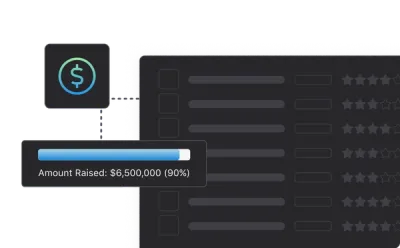
Mastering the art of the pitch is crucial for any startup founder. Whether seeking investment, landing new customers, or forming strategic partnerships, having the right pitch deck can make all the difference. In this article, we'll explore six essential types of pitch decks every startup needs, each tailored to different audiences and situations. Discover how to craft compelling decks that resonate and drive results, from elevator pitches to detailed investor presentations. Prepare to elevate your pitching game and ensure you're always prepared to impress.

Reasons to Have Multiple Pitch Decks
As a startup founder, you’ll find yourself pitching your business to various audiences with unique interests and needs. Relying on a single pitch deck for all these situations can be a major drawback. Here’s why having multiple pitch decks is crucial for your success:
- Tailoring Your Message: Different audiences care about different aspects of your business. Investors want to see your financials, market opportunity, and growth strategy. Potential partners are interested in synergies and shared goals, while customers focus on how your product solves their problems. A one-size-fits-all approach dilutes your message, making it less impactful. By creating tailored decks, you can emphasize the most relevant information for each audience.
- Maximizing Engagement: When your pitch resonates with the audience's specific concerns, you’re more likely to keep their attention and spark interest. A well-targeted pitch shows that you understand their priorities and have taken the time to address them directly. This level of personalization can significantly increase your chances of securing investment, partnerships, or sales.
- Building Credibility: A customized pitch deck demonstrates professionalism and preparedness. It signals your audience that you’re serious about your business and have done your homework. This can build trust and credibility, essential factors when persuading investors or partners to commit to your venture.
- Adapting to Different Scenarios: Pitching is not a one-time event. You’ll need to present your business in various contexts, from quick elevator pitches to detailed investor meetings and product demos. Each scenario requires a different approach. Multiple pitch decks allow you to be agile and adaptable, ready to impress no matter the situation.

Related resource: Board Deck
Types of Pitch Decks Your Team Should Prepare
To navigate the diverse landscape of pitching scenarios, your startup needs a suite of specialized pitch decks. Each deck serves a unique purpose and is tailored to resonate with specific audiences.
Tailoring your pitch is crucial because different stakeholders have different priorities and concerns. Preparing specific decks for various situations ensures that your message is always relevant, compelling, and impactful. Each pitch deck allows you to focus on the aspects that matter most to your audience, making your presentation more effective and persuasive.
Here’s a brief introduction to the types of pitch decks your team should prepare:
- Elevator Pitch Deck: This concise deck is designed for quick, impromptu pitches, where you need to grab attention and spark interest within a few minutes.
- Investor Pitch Deck: Tailored for potential investors, this deck delves deep into your business model, market opportunity, financial projections, and growth strategy.
- Sales Pitch Deck: Created to persuade potential customers or clients, this deck highlights the benefits and features of your product or service.
- Partnership Pitch Deck: This deck focuses on forming strategic alliances by highlighting mutual benefits, synergies, and shared goals.
- Demo Pitch Deck: A highly visual and interactive deck, used to showcase your product in action, emphasizing its functionality and user experience.
- Customer Pitch Deck: Aimed at converting leads into customers, this deck addresses customer pain points and presents your solution convincingly.
In the following sections, we’ll dive deeper into each type of pitch deck, exploring their purposes, key components, and when to use them.
Elevator Pitch Deck
Definition:
An elevator pitch deck is a concise and highly focused presentation designed to quickly communicate the essence of your startup. It typically consists of a few slides and can be delivered in the time it takes to ride an elevator—around 30 seconds to 2 minutes.
Purpose:
The primary purpose of the elevator pitch deck is to grab the audience's attention and spark their interest in your startup. It serves as an introduction to your business, providing just enough information to make the listener want to learn more.
Key Components:
- Introduction: A brief introduction to your startup, including the name and tagline.
- Problem Statement: A clear and concise explanation of the problem your startup addresses.
- Solution: An overview of your product or service and how it solves the problem.
- Value Proposition: A summary of the unique value your startup offers.
- Call to Action: A prompt for the next steps, such as setting up a meeting or requesting further information.
When to Use It:
The elevator pitch deck is ideal for impromptu or brief interactions where you have limited time to make an impression. This includes:
- Networking events
- Casual conversations with potential investors or partners
- Initial introductions at conferences or trade shows
- Any situation where you need to quickly convey the essence of your startup and pique interest
By having a well-crafted elevator pitch deck ready, you can ensure that you’re always prepared to make a strong first impression, no matter how spontaneous the opportunity may be.
Related resource: Teaser Deck
Investor Pitch Deck
Definition:
An investor pitch deck is a detailed presentation designed to provide potential investors with a comprehensive overview of your startup. This deck delves into the critical aspects of your business, including your market opportunity, financial projections, and growth strategy.
Purpose:
The main purpose of the investor pitch deck is to secure funding from venture capitalists, angel investors, or other financial backers. It aims to convince investors that your startup is a viable and lucrative investment opportunity.
Key Components:
- Introduction: Briefly introduce your startup, including its name and a compelling tagline.
- Problem Statement: Clearly articulate the problem your startup addresses and why it matters.
- Solution: Provide a detailed explanation of your product or service and how it solves the identified problem.
- Market Opportunity: Present data on the size of your target market, growth potential, and market trends.
- Business Model: Explain how your startup plans to make money, including revenue streams and pricing strategy.
- Traction: Showcase any early successes, such as user growth, sales figures, partnerships, or pilot projects.
- Competitive Analysis: Identify your main competitors and highlight your competitive advantages.
- Financial Projections: Provide detailed financial forecasts, including projected revenue, expenses, and profitability.
- Team: Introduce your core team members, emphasizing their expertise and relevant experience.
- Funding Requirements: Specify how much funding you are seeking and how you plan to use the capital.
- Call to Action: Encourage investors to take the next step, such as scheduling a follow-up meeting or conducting due diligence.

When to Use It:
The investor pitch deck is used during formal presentations to potential investors. This can occur in various settings, including:
- Venture capital pitch meetings
- Angel investor gatherings
- Startup accelerators and incubators
- Investment competitions and demo days
By preparing a well-structured and persuasive investor pitch deck, you can effectively communicate the potential of your startup and attract the funding needed to scale and grow your business.
Related resource: Seed Round Pitch Deck
Sales Pitch Deck
Definition:
A sales pitch deck is a presentation designed to persuade potential customers or clients to purchase your product or service. It focuses on highlighting the value and benefits your offering brings to the customer, showcasing how it solves their specific problems.
Purpose:
The primary purpose of the sales pitch deck is to convert leads into paying customers by demonstrating the value and effectiveness of your product or service. It aims to build trust and convince the audience that your solution is the best fit for their needs.
Key Components:
- Introduction: Briefly introduce your startup and what you offer, including a compelling tagline.
- Problem Statement: Clearly articulate the customer's pain points and the problems they are facing.
- Solution: Explain how your product or service addresses these pain points and solves the problem effectively.
- Value Proposition: Highlight the unique benefits and value your solution provides to the customer.
- Product Features: Provide a detailed overview of the key features and functionalities of your product or service.
- Customer Testimonials: Include testimonials or case studies from satisfied customers to build credibility and trust.
- Use Cases: Demonstrate how different customers or industries use your product to achieve specific outcomes.
- Pricing: Outline your pricing model and any available packages or options.
- Call to Action: Encourage the audience to take the next step, such as signing up for a demo, starting a trial, or making a purchase.
When to Use It:
The sales pitch deck is used during interactions with potential customers or clients. This includes:
- Sales meetings and presentations
- Product demonstrations
- Follow-up meetings after initial interest
- Trade shows and industry conferences
By having a well-prepared sales pitch deck, you can effectively communicate the value of your product, address any concerns, and persuade potential customers to take action and make a purchase.
Partnership Pitch Deck
Definition:
A partnership pitch deck is a presentation designed to secure strategic alliances with other businesses. It focuses on highlighting the mutual benefits of a partnership, emphasizing how collaboration can drive growth and achieve shared objectives.
Purpose:
The primary purpose of the partnership pitch deck is to persuade potential partners that a collaboration will be mutually beneficial. It aims to demonstrate how working together can create synergies, unlock new opportunities, and deliver value to both parties.
Key Components:
- Introduction: Briefly introduce your startup and what you offer, including a compelling tagline.
- Partnership Opportunity: Clearly articulate the rationale for the partnership and the specific goals you aim to achieve together.
- Mutual Benefits: Highlight the key benefits for both parties, such as increased market reach, shared resources, and enhanced product offerings.
- Market Opportunity: Present data on the market size, growth potential, and how the partnership can capitalize on these opportunities.
- Value Proposition: Explain the unique value each partner brings to the table and how combining strengths can create a competitive advantage.
- Synergies: Identify areas where the partnership can create synergies, such as technology integration, distribution channels, or customer base expansion.
- Case Studies: Include examples of successful partnerships or collaborations that have yielded positive results.
- Implementation Plan: Outline a high-level plan for how the partnership will be executed, including key milestones and responsibilities.
- Call to Action: Encourage the potential partner to take the next step, such as setting up a detailed discussion or signing a memorandum of understanding (MOU).
When to Use It:
The partnership pitch deck is used during meetings with potential partners. This includes:
- Initial discussions with companies you want to collaborate with
- Negotiations to finalize partnership terms
- Presentations at industry events where strategic alliances are sought
- Follow-up meetings to refine partnership details
By preparing a well-structured partnership pitch deck, you can effectively communicate the potential of the collaboration, address any concerns, and persuade potential partners to move forward with the partnership.
Demo Pitch Deck
Definition:
A demo pitch deck is a highly visual and interactive presentation designed to showcase your product in action. It emphasizes the functionality, features, and user experience of your product through live demonstrations or detailed walkthroughs.
Purpose:
The primary purpose of the demo pitch deck is to demonstrate the capabilities and benefits of your product firsthand. It aims to give the audience a clear understanding of how the product works and how it can solve their specific problems or enhance their operations.
Key Components:
- Introduction: Briefly introduce your startup and what you offer, setting the stage for the demo.
- Product Overview: Provide a high-level overview of your product, highlighting its main features and functionalities.
- Live Demonstration: Conduct a live demo or show a video walkthrough of your product in action, focusing on key use cases.
- User Interface: Highlight the user interface and user experience, demonstrating how intuitive and easy-to-use your product is.
- Key Features: Dive deeper into the standout features of your product and explain how they address specific customer needs.
- Use Cases: Present real-world examples or scenarios where your product has been successfully used to solve problems or improve processes.
- Customer Testimonials: Include testimonials or case studies from satisfied customers who have benefited from using your product.
- Call to Action: Encourage the audience to take the next step, such as signing up for a trial, requesting a personalized demo, or making a purchase.
When to Use It:
The demo pitch deck is used during product demonstrations and interactive presentations. This includes:
- Product demo meetings with potential customers or clients
- Trade shows and industry conferences where live demos are expected
- Sales presentations where the audience needs to see the product in action
- Webinars or online demos conducted for a broader audience
By preparing a compelling demo pitch deck, you can effectively showcase the strengths of your product, engage your audience, and persuade potential customers of its value.
Customer Pitch Deck
Definition:
A customer pitch deck is a presentation aimed at converting leads into paying customers. It focuses on addressing the specific pain points of potential customers and presenting your product or service as the ideal solution to their problems.
Purpose:
The primary purpose of the customer pitch deck is to persuade potential customers to purchase your product or service. It aims to build a strong case for why your offering is the best fit for their needs, highlighting the benefits and unique value propositions.
Key Components:
- Introduction: Briefly introduce your startup and what you offer, setting the context for the presentation.
- Problem Statement: Clearly articulate the pain points and challenges faced by the customer that your product or service addresses.
- Solution: Explain how your product or service effectively solves these problems, highlighting its unique features and benefits.
- Value Proposition: Emphasize the unique value your product or service brings to the customer, differentiating it from competitors.
- Product Features: Provide a detailed overview of the key features and functionalities of your product or service.
- Customer Testimonials: Include testimonials or case studies from satisfied customers who have benefited from your offering.
- Use Cases: Present real-world examples or scenarios where your product has been successfully used to solve problems or improve processes.
- Pricing: Outline your pricing model and any available packages or options, making it easy for the customer to understand the cost.
- Call to Action: Encourage the audience to take the next step, such as signing up for a trial, requesting a demo, or making a purchase.
When to Use It:
The customer pitch deck is used during interactions with potential customers who are in the decision-making phase. This includes:
- Sales meetings and presentations
- Follow-up meetings after initial interest has been shown
- Product demonstrations tailored to specific customer needs
- Webinars or online presentations aimed at converting leads
By preparing a compelling customer pitch deck, you can effectively communicate the value of your product, address any concerns, and persuade potential customers to take action and make a purchase.
Get Templates, Tips, and Connect with Potential Investors with Visible

Mastering the art of the pitch is essential for any startup founder. You can ensure your message resonates with each audience by preparing multiple tailored pitch decks—such as elevator, investor, sales, partnership, demo, and customer decks. This targeted approach maximizes engagement, builds credibility, and enhances your chances of achieving your business goals.
Share your pitch deck confidently with Visible, a purpose-built platform for fundraising. Our pitch deck sharing tool is completely integrated with our fundraising CRM and investor updates platform. Founders can also leverage their brand by hosting decks from their own domain and highlighting brand colors.
Try Visible free for 14 days and start strengthening your investor connections.




